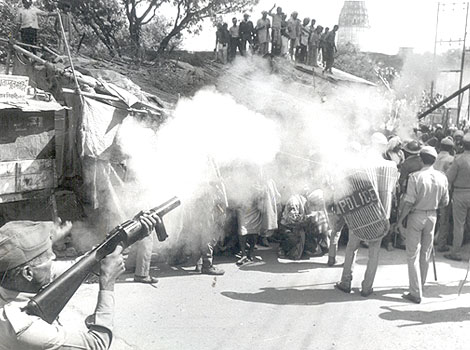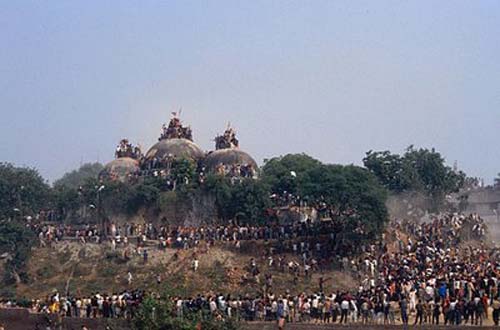Facts about Ram Janmabhoomi-Babri Masjid issue

The story begins in 1526 when Babar, the founder of the Mughal dynasty, invaded India and his general Mir Baqi took Ayodhya and built the Babri Masjid at the highest point of the town overlooking the Ghaghra River.
The main issues revolve around access to this site traditionally regarded as the birthplace of the Lord Rama and whether a previous Hindu temple was demolished or modified to create the mosque.
In 1936, the mosque and surrounding land were registered as Waqf No 26 Faizabad with the UP Sunni Central Board of Waqfs.
On December 22, 1949, about 50 people broke in to the mosque to install idols of Ram and Sita, after which the property came under dispute.
In 1984, the VHP launched a mass movement for the opening of the locks of the mosque, and in 1985 the Rajiv Gandhi government ordered the locks to be removed.
On December 6, 1992, Hindu Karsevaks destroyed the mosque in Ayodhya in an attempt to reclaim the land.
The demolition occurred after a religious ceremony turned violent and resulted in several months of intercommunal rioting between India's Hindu and Muslim communities, causing the death of at least 2,000 people most of whom were muslims.

But even going by the Hindus' version that mosque was built on the land where temple existed, this is no reason to demolish that structure in post-cold war era in view of full presence of national and international media.
A subsequent land title case was lodged in the Allahabad High Court, the verdict of which was pronounced 30th of September, 2010.
In the landmark hearing, the three judges of The Allahabad High Court ruled that the 2.77 acres (1.12 ha) of Ayodhya land be divided into 3 parts, with 1/3 going to the Ram Lalla or Infant Lord Rama represented by the Hindu Maha Sabha for the construction of the Ram temple, 1/3 going to the Islamic Sunni Waqf Board and the remaining 1/3 going to a Hindu religious denomination Nirmohi Akhara.
While the three-judge bench was not unanimous that the disputed structure was constructed after demolition of a temple, it did agree that a temple or a temple structure predated the mosque at the same site.
The excavations by the Archaeological Survey of India were heavily used as evidence by the court that the predating structure was a massive Hindu religious building.
Below is history, chronology, timeline of the Ram Temple and Babri Mosque Demolition:
1. 1528: Babur, Mughal Empire, builds a mosque in Ram Janmabhoomi, Ayodhya. Some Hindus say Ram Janmabhoomi is the birthplace of Lord Rama.
2. 1853: First recorded incidents of religious violence at the site.
3. 1855: Hindus and Muslims clash over possession of the mosque. There are claims that Sita Rasoi and Ram Chabootara were built around this time.
4. 1859: British colonial administration erects a fence to separate the places of worship, allowing the inner court to be used by Muslims and the outer court by Hindus.
5. 1885: Mahant Raghubar Das files a suit seeking permission to build a canopy on Ram Chabootra.
6. 1949: Idols of Lord Rama appear inside mosque allegedly placed there by Hindus. Muslims protest and both parties file civil suits. The government proclaims the premises a disputed area and locks the gates.
7. 1950: Gopal Singh Visharad and Mahant Paramhand Ramchandra Das file suits in Faizabad, asking for permission to offer prayers to the idols installed at Asthan Janmabhoomi. Inner courtyard gates are locked, but puja is allowed.
8. 1959: Nirmohi Akhara and Mahant Raghunath file a case, claiming to be the sect responsible for conducting puja.
9. 1961: Sunni Central Board of Waqfs, UP, files a case claiming the mosque and the surrounding land was a graveyard.
10. 1984: Hindus form a committee to "liberate" the birth-place of Lord Rama and build a temple in his honor, spearheaded by the Vishwa Hindu Parishad party (VHP). Then Bharatiya Janata Party (BJP) leader Lal Krishna Advani takes over leadership of campaign.
11. 1986: On a petition of Hari Shanker Dubey, a judge directs masjid gates be unlocked to allow darshan.District judge orders the gates of the disputed mosque opened to allow Hindus to worship there. Muslims set up Babri Mosque Action Committee in protest.
12. 1989: VHP steps up campaign, laying the foundations of a Rama temple on land adjacent to the disputed mosque. Former VHP vice-president Justice Deoki Nandan Agarwal files a case, seeking the mosque be shifted elsewhere.
13. 1990: VHP volunteers partially damage the mosque. Prime Minister Chandra Shekhar tries to resolve the dispute through negotiations, which fail the next.
14. 1991: BJP comes to power in Uttar Pradesh state, where Ayodhya is located.
15. 1992: The mosque is torn down by supporters of the VHP, the Shiv Sena party and the BJP, prompting nationwide rioting between Hindus and Muslims in which more than 2,000 people die.
16. 1998: The BJP forms coalition government under Prime Minister Atal Behari Vajpayee.
17. 2001: Tensions rise on the anniversary of the demolition of the mosque. VHP pledges again to build Hindu temple at the site.
18. 2002: The High Court directs the Archaeological Survey of India to excavate the site to determine if a temple lay underneath.
19. Jan 2002: Mr Vajpayee sets up an Ayodhya cell in his office and appoints a senior official, Shatrughna Singh, to hold talks with Hindu and Muslim leaders.
20. Feb 2002: BJP rules out committing itself to the construction of a temple in its election manifesto for Uttar Pradesh assembly elections. VHP confirms deadline of 15 March to begin construction. Hundreds of volunteers converge on site. At least 58 people are killed in an attack on a train in Godhra which is carrying Hindu activists returning from Ayodhya.
21. Mar 2002: Between 1,000 and 2,000 people, mostly Muslims, die in riots in Gujarat following the train attack.
22. Apr 2002: Three High Court judges begin hearings on determining who owns the religious site.
23. Jan 2003: Archaeologists begin a court-ordered survey to find out whether a temple to Lord Rama existed on the site.
24. Aug 2003: The survey says there is evidence of a temple beneath the mosque, but Muslims dispute the findings. Mr Vajpayee says at the funeral of Hindu activist Ramchandra Das Paramhans that he will fulfill the dying man's wishes and build a temple at Ayodhya. However, he hopes the courts and negotiations will solve the issue.
25. Sept 2003: A court rules that seven Hindu leaders should stand trial for inciting the destruction of the Babri Mosque, but no charges are brought against Mr Advani, now deputy prime minister, who was also at the site in 1992.
26. Oct 2004: Mr Advani says his party still has "unwavering" commitment to building a temple at Ayodhya, which he said was "inevitable".
27. Nov 2004: A court in Uttar Pradesh rules that an earlier order which exonerated Mr Advani for his role in the destruction of the mosque should be reviewed.
28. July 2005 Suspected Islamic militants attack the disputed site, using a jeep laden with explosives to blow a hole in the wall of the complex. Security forces kill five people they say are militants, and a sixth who was not immediately identified.
29. June 2009: The Liberhan commission investigating events leading up to the mosque's demolition submits its report. Its contents are not made public.
30. July 2010 - On July 27, the court took the initiative for an amicable solution to the dispute when it called on counsel for the contending parties to go into the possibility. But no headway was made.
31. September 2010 - The Special Bench, comprising Justices S.U. Khan, D.V. Sharma and Sudhir Agarwal, said that Mr. Tripathi's application lacked merit. It also imposed “exemplary costs” of Rs. 50,000, terming his effort for an out-of-court settlement as a “mischievous attempt.”
32. Mr. Tripathi's plea was opposed by the Akhil Bhartiya Hindu Mahasabha and the Sunni Central Board of Waqfs, which submitted separate replies to the OSD on September 16. Stating that an amicable solution was not possible, they alleged that the application was mala fide.
33. 30 September 2010 - The judgment on the 60- year-old title suit was pronounced.
You May Be Interested IN